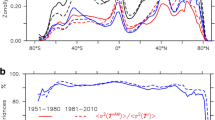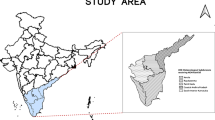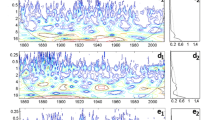Abstract.
The tropical Atlantic meridional SST gradient (TAMG) is a mode of climatic variability known to be largely associated with abnormal rainfall regimes in South America and West Africa. A TAMG index is defined by the difference between area indices of sea surface temperature anomaly north (TN index) and south (TS index) of the meteorological equator (∼5°N). We investigate, for the 1964–1998 period, the decadal variability of the TAMG index and the relationship of its TN and TS components with the Southern Oscillation Index (SOI), the North Atlantic Oscillation (NAO), sea level pressure (SLP) signals in South Atlantic islands, the global NCEP-NCAR SLP field, and sea-ice extent data in the Southern Ocean. We explore the relationship between the SOI and the TN and TS signals, after estimating their fluctuating lags with the cross-wavelet transform technique. The SOI always leads TN with an average time lead of 5.4 months. On the contrary, TS leads the SOI by ∼4 months after 1984. When exploring the origin of such a precursory event of the SOI, observed in TS, it is found that the highest correlation between TS, the global SLP field, and the sea-ice extent around Antarctica is located in the Ross sea, where the ice signal leads the SOI. High correlation between TS and the SLP field is also observed in the western tropical Pacific. The continuous wavelet transform is then used to extract the low-frequency components of the TN and TS signals. These components are strong well-defined oscillations with mean periods at 9.6 years for TN and 14 years for TS. Given this asynchronous non-dipole nature of the TN and TS decadal components, we can anticipate that the TAMG undergoes decadal oscillations that are variable on a longer multi-decadal timescale. These components are also very similar to the low-frequency components of the NAO index, for TN (with the NAO leading TN by 14 months) and SLP anomaly signals at St. Helena and Tristan da Cunha islands, for TS. These results indicate that the TN or TS decadal component is each related to the larger climatic milieu in the same hemisphere, but that the climatic milieu of the South Atlantic is distinct from that of the North Atlantic.














Similar content being viewed by others
References
Basnett TA, Parker DE (1997) Development of the Global Mean Sea Level Pressure Data Set GMSLP2. Report CRTN 79 of the Hadley Centre for Climate Prediction and Research, Meteorological Office, London Road, Bracknell, Berkshire RG12 2SY, UK
Bromwich DH, Chen B, Hines KM (1998) Global atmospheric impacts induced by year-round open water adjacent to Antarctica. J Geophys Res 103: 11,173–11,189
Camberlin P, Diop M (1999) Inter-relationships between groundnut yield in Senegal, interannual rainfall variability and sea-surface temperatures. Theor Appl Climatol 63: 16–181
Cane MA, Zebiak SE, Dolan SC (1986) Experimental forecasts of El Niño. Nature 322: 827–832
Carton JA, Cao X, Giese BS, da Silva AM (1996) Decadal and interannual SST variability in the tropical Atlantic. J Phys Oceanogr 26: 1165–1175
Chang P, Ji L, Li H (1997) A decadal climate variations in the tropical Atlantic Ocean from thermodynamic air–sea interactions. Nature 385: 516–518
Chang P, Ji L, Saravanan R (2001) A hybrid coupled model study of tropical Atlantic variability. J Clim 14: 361–390
Covey DL, Hastenrath S (1978) The Pacific El Niño phenomenon and the Atlantic circulation. Mon Weather Rev 106: 1280–1287
Daubechies I (1992) Ten lectures on wavelets. Society for Industrial and Applied Mathematics Press, vol 16 of CBMS-NSF Regional Conference Series in Applied Mathematics, Philadelphia USA, pp 357
Davies RE (1976) Predictability of sea surface temperature and sea level pressure anomalies over the North Pacific Ocean. J Phys Oceanog 6: 249–266
Delécluse P, Servain J, Levy C, Arpe K, Bengtsson L (1994) On the teleconnection between the 1984 Atlantic warm event and the 1982–1983 ENSO. Tellus 46A: 448–464
Delprat N, Escuidé B, Guillemain P, Kronland-Martinet R, Tchamitchian P, Torrésani B (1992) Asymptotic wavelet and Gabor analysis: extraction of instantaneous frequencies. IEEE Trans Inform Theory 38: 644–664
Déqué M, Servain J (1989) Teleconnection between tropical Atlantic sea surface temperature and midlatitude 50 kPa heights during 1964–1986. J Clim 2: 929–944
Enfield DB, Mayer DA (1997) Tropical Atlantic sea surface variability and its relation to El Niño – Southern Oscillation. J Geophys Res 102: 929–945
Enfield DB, Mestas-Nuñez AM, Mayer DA, Cid-Serrano L (1999) How ubiquitous is the dipole relationship in tropical Atlantic sea surface temperatures? J Geophys Res 104: 7841–7848
Fichefet T, Tartinville B, Goosse H (2002) Antarctic sea ice variability during 1958–1999: A simulation with a global ice-ocean model. J Geophys Res (in press)
Folland C, Palmer T, Parker D (1986) Sahel rainfall and worldwide sea temperature: 1901–85. Nature 320: 602–606
Giannini A, Cane MA, Kushnir Y (2001) Interdecadal changes in the ENSO teleconnection to the Caribbean region and the north Atlantic oscillation. J Clim 14: 2867–2879
George SE, Saunders MA (2001) North Atlantic oscillation impact on tropical north Atlantic winter atmospheric variability. Geophys Res Lett 28: 1015–1018
Gill AE (1980) Some simple solutions for heat-induced tropical circulation. Q J R Meteorol Soc 106: 447–462
Guillemain D, Kronland-Martinet R (1996) Characterization of acoustic signals through continuous linear time-frequency representations. Proc IEEE 84: 561–585
Hameed S, Sperber KR, Meinster A (1993) Teleconnections of the Southern Oscillation in the tropical Atlantic sector in the OSU coupled upper ocean–atmosphere GCM. J Clim 6: 487–498
Harzallah A, Rocha de Aragao JO, Sadourny R (1996) Interannual rainfall variability in northeast Brazil: observation and model simulation. Int J Climatol 16: 861–878
Hastenrath S (1990) Prediction of northeast Brazil rainfall anomalies. J Clim 3(8): 893–904
Hastenrath S, Lamb P (1977) Some aspects of circulation and climate over the eastern equatorial Atlantic. Mon Weather Rev 105: 1019–1023
Hastenrath S, de Castro LC, Aceituno P (1987) The Southern Oscillation in the Atlantic sector. Contrib Atmos Phys 60: 447–463
Houghton RW, Tourre YM (1992) Characteristics of low-frequency sea surface temperature fluctuations in the tropical Atlantic. J Clim 5: 765–771
Hurrell JW (1995) Decadal trends in the North Atlantic Oscillation: regional temperatures and precipitations. Science 269: 676–679
Janicot S (1997) Impact of warm ENSO events on atmospheric circulation and convection over the tropical Atlantic and West Africa. Ann Geophysicae 15: 471–475
Janicot S, Moron V, Fontaine B (1996) Sahel droughts and ENSO dynamics. Geophys Res Lett 23: 515–518
Janicot S, Harzallah A, Fontaine B, Moron V (1998) West African monsoon dynamics and eastern equatorial Atlantic and Pacific SST anomalies (1970–88). J Clim 11: 1874–1882
Jury MR, Enfield DB, Mélice J-L (2002) Tropical monsoons around Africa: stability of El Niño-Southern Oscillation associations and links with continental climate. J Geophys Res 107 (C10): 15–1, 15–17
Kistler R, and collaborators (2001) The NCEP-NCAR 50 year reanalysis: monthly means CD-ROM and documentation. Bull Am Meteorol Soc 7: 247–267
Kushnir Y (1994) Interdecadal variations in North Atlantic sea surface temperature and associated atmospheric conditions. J Clim 7: 141–157
Lamb PJ (1978a) Large-scale tropical Atlantic surface circulation patterns associated with sub-Saharan weather anomalies. Tellus 30: 240–251
Lamb PJ (1978b) Case studies of tropical Atlantic surface circulation patterns during recent sub-saharan weather anomalies: 1967 and 1968. Mon Weather Rev 106: 482–491
Lamb PJ, Peppler RA (1987) North Atlantic Oscillation: concept and application. Bull Am Meteorol Soc 68: 1218–1225
Lanzante JR (1996) Lag relationships involving tropical sea surface temperatures. J Clim 9: 2568–2578
Lau KM, Weng HY (1995) Climate signal detection using wavelet transform: how to make a time series sing. Bull Am Meteorol Soc 76: 2391–2402
Lough JM (1986) Tropical Atlantic sea surface temperature and rainfall variations in Sub-Saharan Africa. Mon Weather Rev 114: 561–570
Mallat S (1998) A wavelet tour of signal processing. Academic Press, San Diego, CA, USA, pp 577
Mestaz-Nuñez AM, Enfield DB (2001) Eastern equatorial Pacific SST variability: ENSO and non-ENSO components and their climatic associations. J Clim 14: 391–402
Mechoso CR, Lyons SW, Spahr JA (1990) The impact of sea surface temperature anomalies on the rainfall over northeast Brazil. J Clim 3: 812–826
Meehl GA, van Loon H (1979) The seesaw in winter temperatures between Greenland and Northern Europe. Part III: teleconnections with lower latitudes. Mon Weather Rev 107: 1095–1106
Mehta VM (1998) Variability of the tropical ocean surface temperature at decadal–multidecadal timescale. Part I: the Atlantic Ocean. J Clim 11: 2351–2375
Meyers SD, Kelley BG, O'Brien JJ (1993) An introduction to wavelet analysis in oceanography and meteorology: with application to the dispersion of Yanai waves. Mon Weather Rev 121: 2858–2866
Morlet J (1983) Sampling theory and wave propagation. NATO ASI Series FI, Springer, Berlin Heidelberg New York, pp 233–261
Moura AD, Shukla J (1981) On the dynamics of droughts in northeast Brazil: observations, theory and numerical experiments with a general circulation model. J Atmos Sci 38: 2653–2675
Nobre P, Shukla J (1996) Variations of sea surface temperature, wind stress and rainfall over the tropical Atlantic and South America. J Clim 9: 2464–2579
Peterson RG, White WB (1998) Slow oceanic teleconnections linking the Antarctic circumpolar wave with the tropical El Niño-Southern Oscillation. J Geophys Res 103: 24,573–24,583
Rao VB, Chapa SR, Franchito SH (1999) Decadal variation of atmosphere–ocean in the tropical Atlantic and its relationships to the northeast Brazil rainfall. J Meteorol Soc Japan 77: 63–75
Robertson AW, Mechoso CR, Kim YJ (2000) The influence of Atlantic sea surface temperature anomalies on the North Atlantic Oscillation. J Clim 13: 122–138
Rodwell MJ, Powell DP, Folland CK (1999) Oceanic forcing of the wintertime North Atlantic Oscillation and European climate. Nature 398: 320–323
Seager R, Kushnir Y, Chang P, Naik N, Miller J, Hazeleger W (2001) Looking for the role of the ocean in tropical Atlantic decadal climate variability. J Clim 14: 638–654
Servain J (1991) Simple climatic indices for the tropical Atlantic Ocean and some applications. J Geophys Res 96: 15,137–15,146
Servain J, Lukas S (1990) Climatic atlas of the tropical Atlantic wind stress and sea surface temperature 1985–1989. Institut Français de Recherche pour l'Exploitation de la Mer, Plouzané, France, pp 143
Servain J, Merle J (1993) Interannual climate variations over the tropical Atlantic Ocean. NATO ASI Series vol 16. In: Shukla J (ed) Prediction of interannual climate variations. Springer, Berlin Heidelberg, pp 153–171
Servain J, Séva M, Rual P (1990) Climatology comparison and long-term variations of sea surface temperature over the tropical Atlantic Ocean. J Geophys Res 95: 9421–9431
Servain J, Busalacchi AJ, McPhaden MJ, Moura AD, Reverdin G, Vianna M, Zebiak SE (1998) A pilot research moored array in the tropical Atlantic (PIRATA). Bull Am Meteorol Soc 79: 2019–2031
Simmonds I, Jacka TH (1995) Relationships between the interannual variability of Antarctic sea ice and the southern oscillation. J Clim 8: 637–647
Tanimoto Y, Xie SP (1999) Ocean–atmosphere variability over the pan-Atlantic basin. J Meteorol Soc Japan 77: 31–46
Torrence C, Compo GP (1997) A practical guide to wavelet analysis. Bull Am Meteorol Soc 79: 61–78
van Loon H, Rogers JC (1978) The seesaw in winter temperatures between Greenland and Northern Europe. Part I: general description. Mon Weather Rev 106: 296–310
Venegas SA, Mysak LA, Straub DN (1998) An interdecadal climate cycle in the South Atlantic and its links to other ocean basins. J Geophys Res 103: 24,723–24,736
Wagner RG (1996) Decadal-scale trends in mechanisms controlling meridional sea surface temperature gradients in the tropical Atlantic. J Geophys Res 101: 16,683–16,694
Wainer I, Soares J (1997) North-northeast Brazil rainfall and its decadal-scale relationship to wind stress and sea surface temperature. Geophys Res Lett 24: 277–280
Wainer I, Venegas SA (2002) South Atlantic multidecadal variability in the climate system model. J Clim 15: 1408–1420
Wallace JM, Zhang Y, Bajuk L (1996) Interpretation of interdecadal trends in Northern Hemisphere surface air temperature. J Clim 9: 249–259
Wang CZ (2002) Atlantic climate variability and its associated atmospheric circulation cells. J Clim 15: 1911–1925
White WB, Peterson RG (1996) An Antarctic circumpolar wave in surface pressure, wind, temperature and sea-ice extent. Nature 380: 699–702
Wright PB (1986) Precursors of the Southern Oscillation. Int J Climatol 6: 17–30
Xie SP, Tanimoto Y (1998) A pan-Atlantic decadal climate oscillation. Geophys Res Lett 25: 2185–2188
Yang J (1999) A linkage between decadal climate variations in the Labrador Sea and the tropical Atlantic Ocean. Geophys Res Lett 26: 1023–1026
Yuan X, Martinson DG (2000) Antarctic sea ice extent variability and its global connectivity. J Clim 13: 1697–1717
Zhao W, Khalil MAK (1993) The relationship between precipitation and temperature over the contiguous United States. J Clim 6: 1232–1236
Acknowledgements.
We wish to acknowledge the valuable comments of the two very thorough reviewers.
Author information
Authors and Affiliations
Corresponding author
Appendix A
Appendix A
1.1 Cross-wavelet spectrum and estimation of the instantaneous phase difference and time lag between two time series
The continuous wavelet transform (CWT) (e.g. Daubechies 1992; Lau and Weng 1995; Torrence and Compo 1997; Mallat 1998) of a signal x(t) with the analysing wavelet ψ is defined as:
where a is the dilatation parameter, b is the time translation parameter and * denotes the complex conjugate. We use the complex Morlet wavelet (Morlet 1983):
with \(i = \sqrt {- 1} \) and \( \omega _0 = \sqrt {2/\ln 2} \cong 5.34 \) (Daubechies 1992). With this wavelet, the wavelet transform coefficient W x (b, a) may be expressed in terms of real and imaginary parts, modulus and phase, and the relation between the dilatation parameter a and the usual frequency f is f(a) = ω(a)/2π = 0.874/a (Meyers et al. 1993).
The cross-wavelet spectrum of two series x(t) and y(t) is defined as:
where W x (b, a) and W y (b, a) are the CWT of x(t) and y(t) respectively and where * denotes the complex conjugate. The cross-wavelet coefficient W xy (b, a) is a complex number and may be expressed in terms of real and imaginary parts, modulus and phase difference. Indeed, let us recall that if z 1 = c 1 exp(iθ1) and z 2 = c 2 exp(iθ2) are two complex numbers with phases θ1 and θ2, then z 1 z 2* = c 1 c 2 exp[i(θ1 – θ2)] is a complex number with phase: Δθ = θ1 – θ2.
Consequently, the cross-wavelet spectrum provides an estimation of the local phase difference Δφ(b, a) between the two series for each point of the (b, a) time-frequency space. This local phase difference is independent of the amplitude of the series in the sense that Δφ(b, a) will not vary substantially if the amplitude of the series is modified for any location parameter b (or time t). These characteristics allow us to estimate the instantaneous phase difference between the two series x(t) and y(t). Keeping in mind that b corresponds to the time t, this phase difference is defined as:
where Re[W xy (b, a)] and Im[W xy (b, a)] are the real and imaginary parts of W xy (b, a) and where a 1 < a 2 are the lower and upper limits of the dilatation parameter. The instantaneous time lag between x(t) and (t) is then obtained from the relation:
where F(b) is the instantaneous frequency. We define this frequency as the first normalized moment in frequency of W xy (b, a):
where f(a) is the frequency corresponding to the dilatation parameter a and where |W xy (b, a)| is the modulus of W xy (b, a).
Rights and permissions
About this article
Cite this article
Mélice, JL., Servain, J. The tropical Atlantic meridional SST gradient index and its relationships with the SOI, NAO and Southern Ocean. Climate Dynamics 20, 447–464 (2003). https://doi.org/10.1007/s00382-002-0289-x
Received:
Accepted:
Published:
Issue Date:
DOI: https://doi.org/10.1007/s00382-002-0289-x




